C Major Entertainment
422 products
-
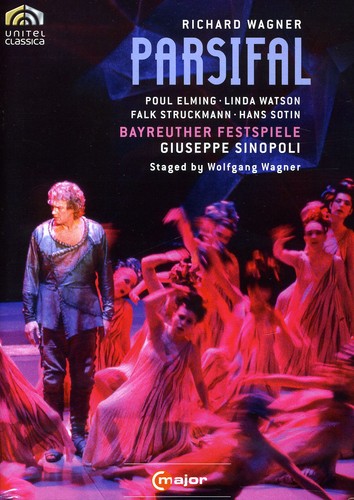
-
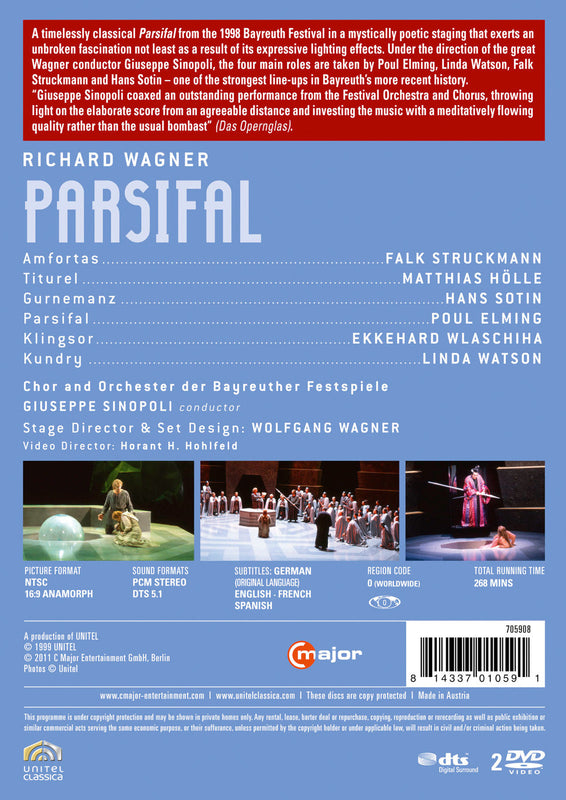
-
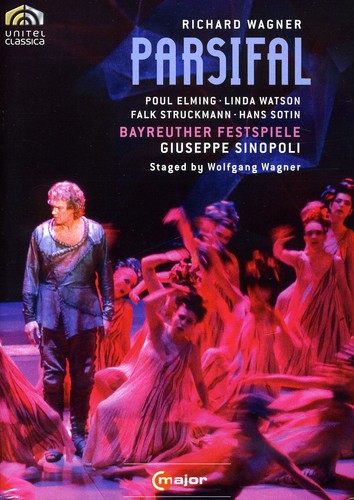 {# optional: put hover video/second image here positioned absolute; inset:0 #}
C Major Entertainment
{# optional: put hover video/second image here positioned absolute; inset:0 #}
C Major EntertainmentWagner: Parsifal / Sinopoli, Struckmann, Watson, Elming, Holle
Richard WagnerPARSIFALAmfortas – Falk StruckmannTiturel – Matthias HölleGurnemanz – Hans SotinParsifal – Poul ElmingKlingsor – Ekkehard WlaschihaKundry – Linda WatsonBayreuth Festival Chorus...
$51.99May 31, 2011 -
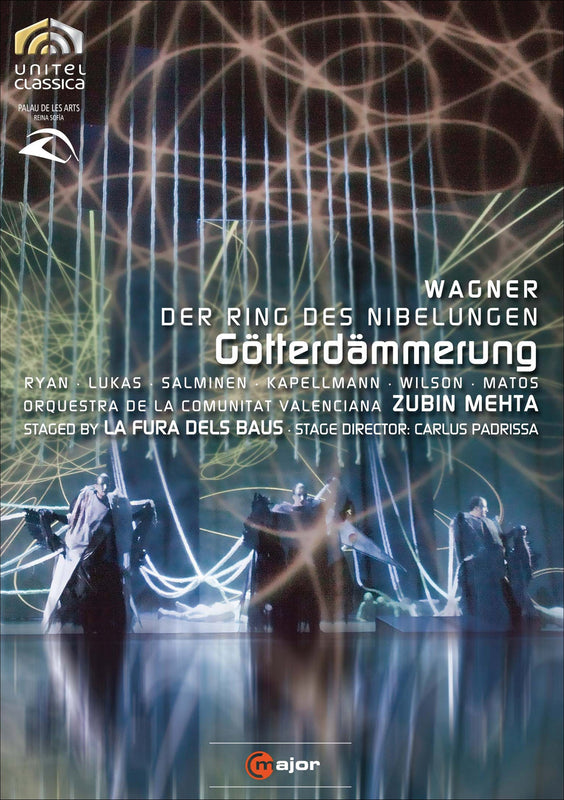
-
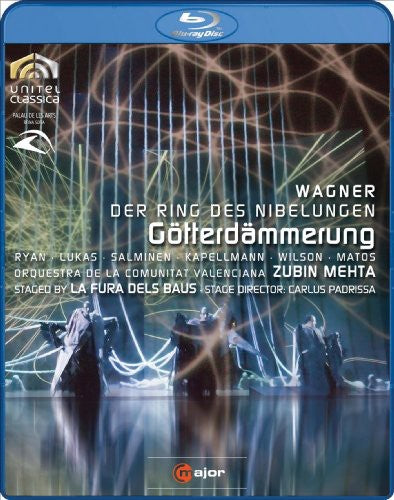
-
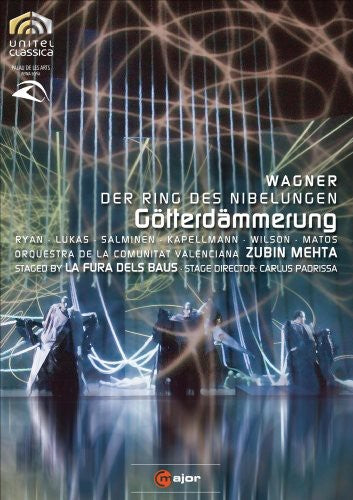
-
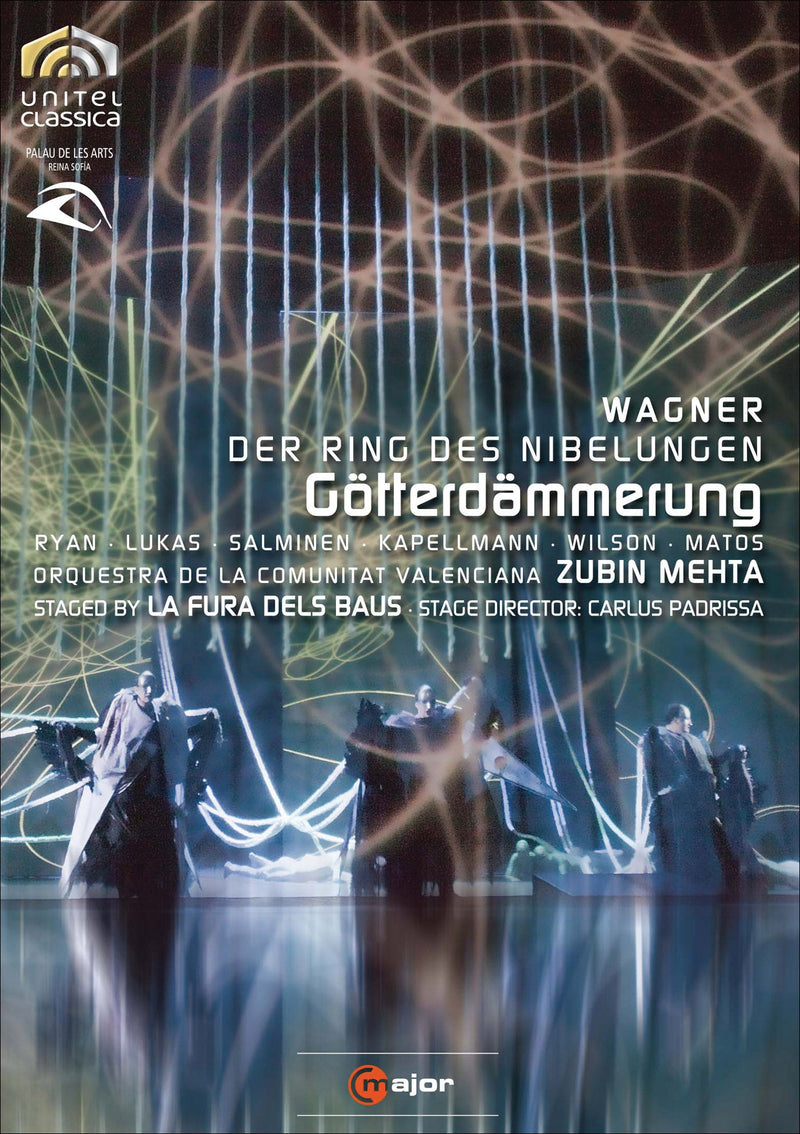 {# optional: put hover video/second image here positioned absolute; inset:0 #}
C Major Entertainment
{# optional: put hover video/second image here positioned absolute; inset:0 #}
C Major EntertainmentWagner: Götterdammerung / Mehta, Ryan, Lukas, Salminen
Richard Wagner GÖTTERDÄMMERUNG Siegfried – Lance Ryan Gunther – Ralf Lukas Alberich – Franz-Josef Kapellmann Hagen – Mattil Salminen Brünnhilde – Jennifer...
$45.99February 23, 2010 -
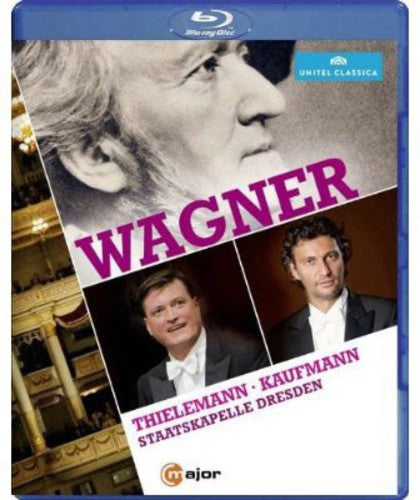
-
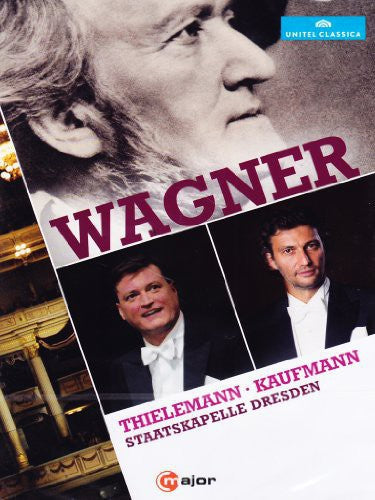
-
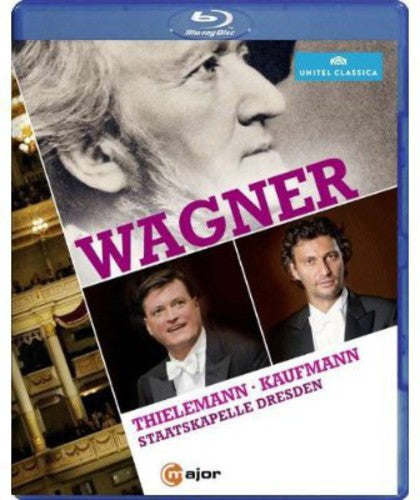 {# optional: put hover video/second image here positioned absolute; inset:0 #}
C Major Entertainment
{# optional: put hover video/second image here positioned absolute; inset:0 #}
C Major EntertainmentWagner Gala / Kaufmann, Thielemann, Dresden
Also available on Blu-ray THE WAGNER GALA In memory of the great Richard Wagner and mindful of their own Wagner tradition, the...
$32.99January 28, 2014 -
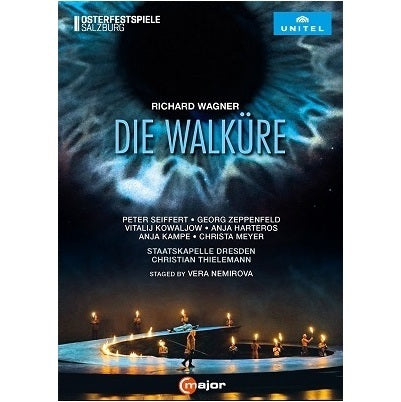
-
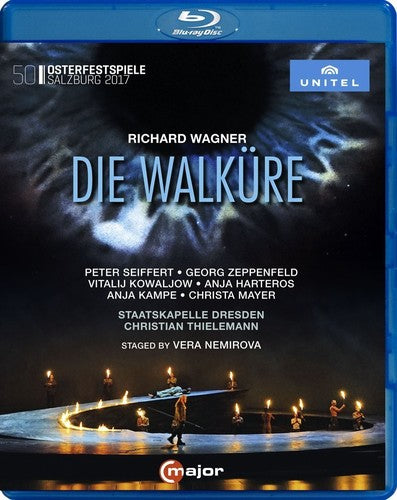
-
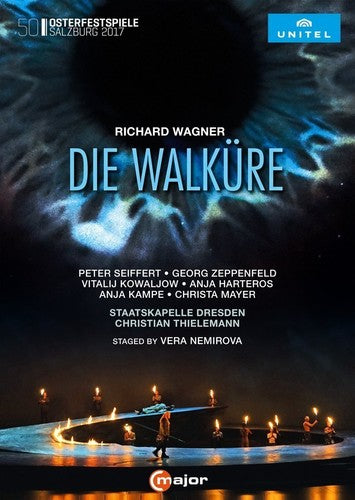
-
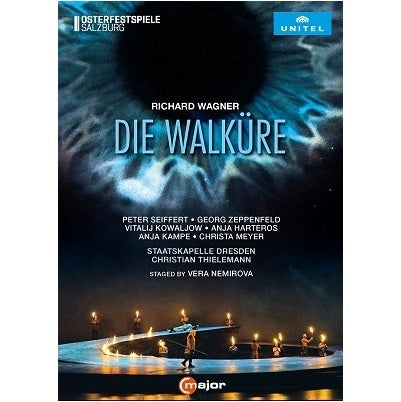 {# optional: put hover video/second image here positioned absolute; inset:0 #}
On SaleC Major Entertainment
{# optional: put hover video/second image here positioned absolute; inset:0 #}
On SaleC Major EntertainmentWagner: Die Walküre / Thielemann, Staatskapelle Dresden
Christian Thielemann has recorded Die Walküre more than once before, not least as part of his Ring cycles for both the Vienna...
November 17, 2017$45.99$25.98 -
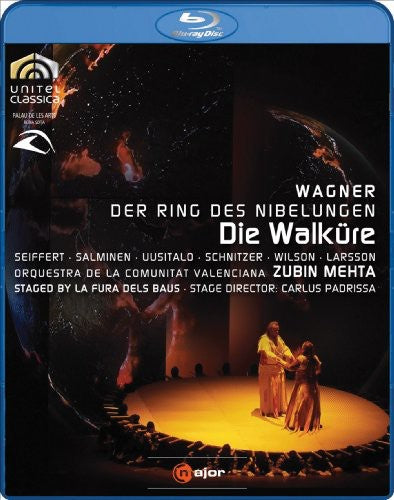
-
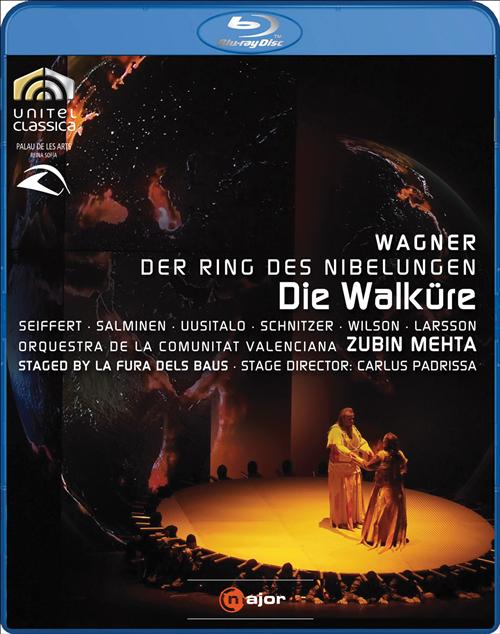
-
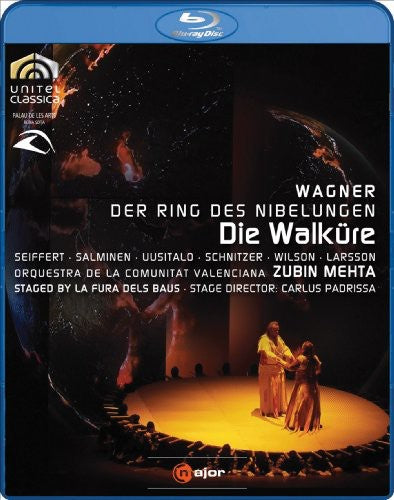 {# optional: put hover video/second image here positioned absolute; inset:0 #}
C Major Entertainment
{# optional: put hover video/second image here positioned absolute; inset:0 #}
C Major EntertainmentWagner: Die Walkure / Mehta, Seiffert, Schnitzer, Wilson
Richard Wagner DIE WALKÜRESiegmund – Peter Seiffert Hunding – Matti Salminen Wotan – Juha Uusitalo Sieglinde – Petra-Maria Schnitzer Brünnhilde – Jennifer Wilson...
$45.99January 26, 2010 -
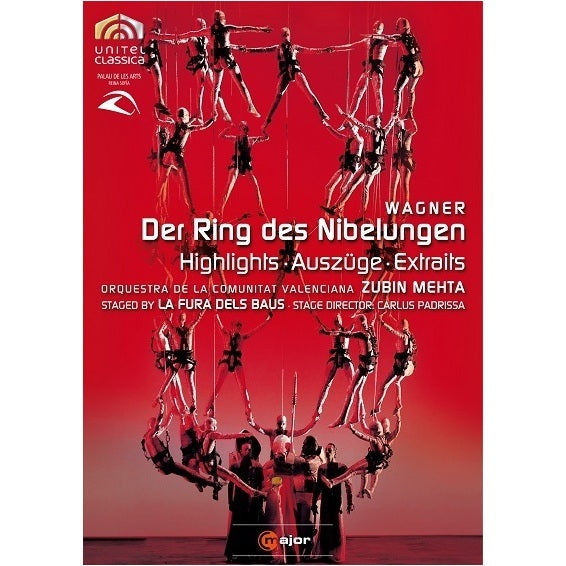
-
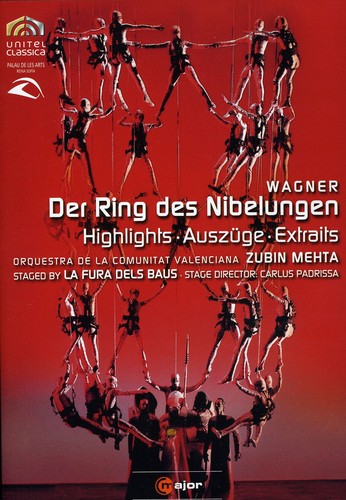
-
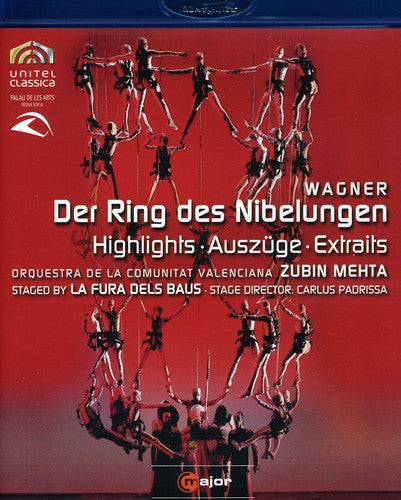
-
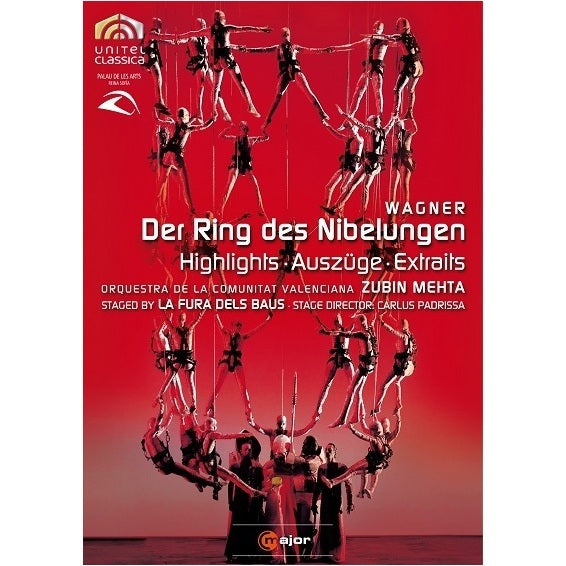 {# optional: put hover video/second image here positioned absolute; inset:0 #}
On SaleC Major Entertainment
{# optional: put hover video/second image here positioned absolute; inset:0 #}
On SaleC Major EntertainmentWagner: Der Ring des Nibelungen Highlights / Mehta, Valencia Orchestra
Richard Wagner DER RING DES NIBELUNGEN(Highlights)Wotan / Der Wanderer – Juha UusitaloLoge – John DaszakAlberich – Franz-Josef KapellmannFasolt / Hunding – Matti SalminenFafner...
November 16, 2010$11.99$5.99 -
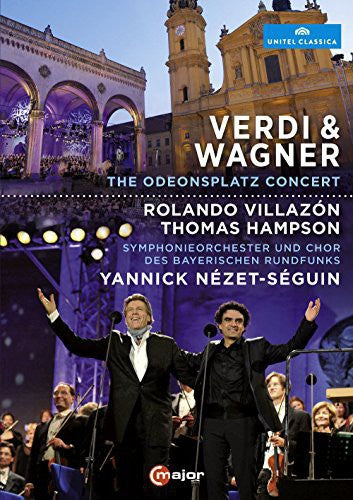
-
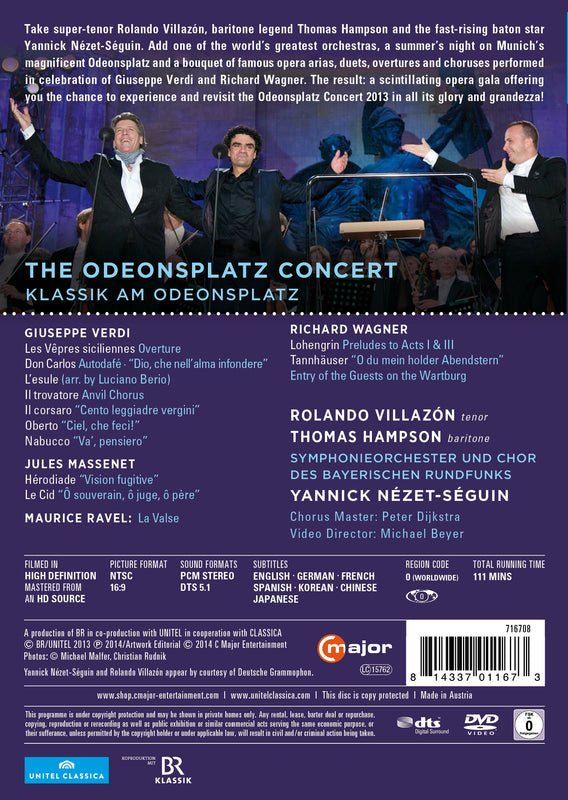
-
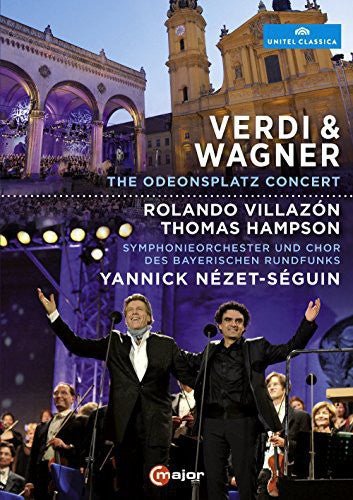 {# optional: put hover video/second image here positioned absolute; inset:0 #}
C Major Entertainment
{# optional: put hover video/second image here positioned absolute; inset:0 #}
C Major EntertainmentVerdi & Wagner - The Odeonsplatz Concert / Thomas Hampson, Ronaldo Villazon, Yannick Nezet-seguin
Also available on Blu-ray This scintillating opera gala offers you the chance to experience the Odeonsplatz Concert 2013 with Rolando Villazón, Thomas...
$26.99July 29, 2014 -
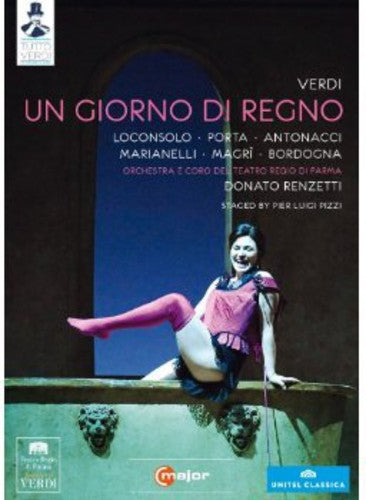
-
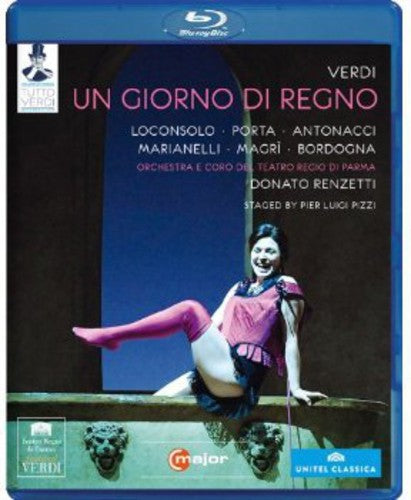
-
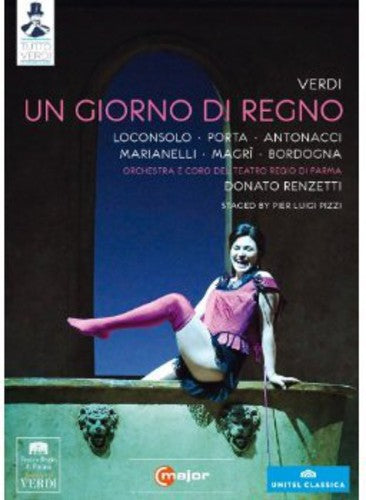 {# optional: put hover video/second image here positioned absolute; inset:0 #}
C Major Entertainment
{# optional: put hover video/second image here positioned absolute; inset:0 #}
C Major EntertainmentVerdi: Un Giorno Di Regno / Loconsolo, Porta, Renzetti
VERDI Un giorno di regno • Donato Renzetti, cond; Guido Loconsolo (Belfiore); Anna Caterina Antonacci (Marchesa del Poggio); Ivan Magri (Edoardo); Alessandra...
$35.99September 25, 2012 -
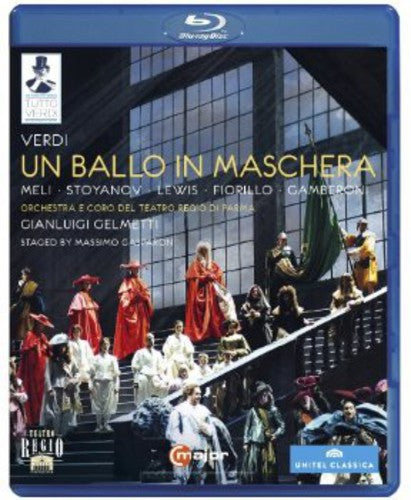
-
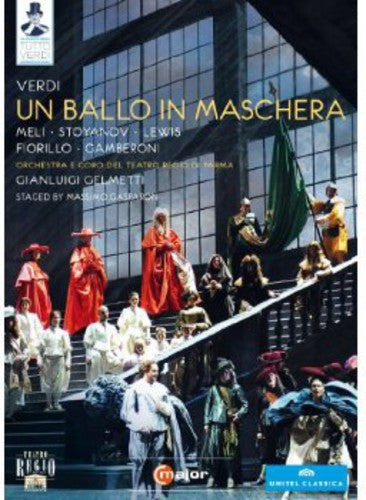
-
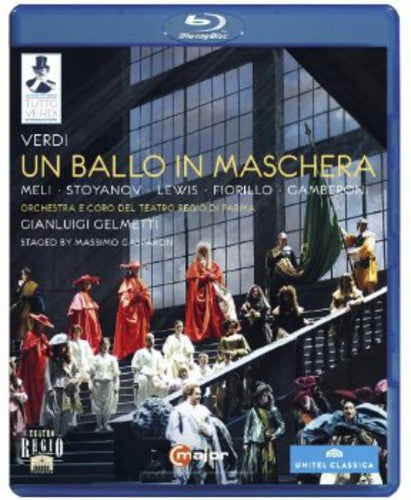 {# optional: put hover video/second image here positioned absolute; inset:0 #}
C Major Entertainment
{# optional: put hover video/second image here positioned absolute; inset:0 #}
C Major EntertainmentVerdi: Un Ballo In Maschera / Meli, Stoyanov, Gelmetti
Also available on Blu-ray Subtitles: English, German, French, Spanish, Italian, Japanese, Korean, Chinese Booklet: English, German, French No. of Discs: 1 Run...
$51.99May 28, 2013 -
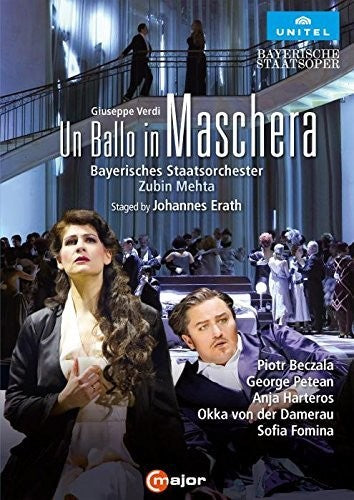
-
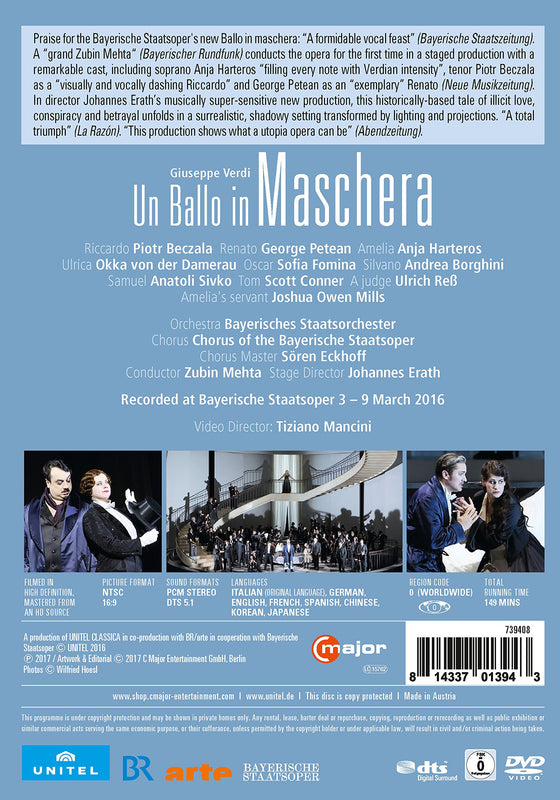
-
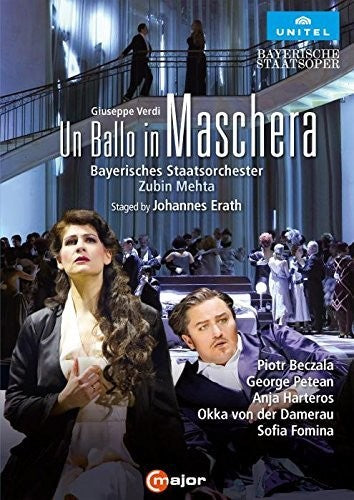 {# optional: put hover video/second image here positioned absolute; inset:0 #}
C Major Entertainment
{# optional: put hover video/second image here positioned absolute; inset:0 #}
C Major EntertainmentVerdi: Un ballo in maschera / Mehta, Bavarian State Orchestra
Praise for the Bayerische Staatsoper's new Ballo in Maschera: "A formidable vocal feast" (Bayerische Staatszeitung). Ten years after stepping down as music...
$35.99March 24, 2017 -
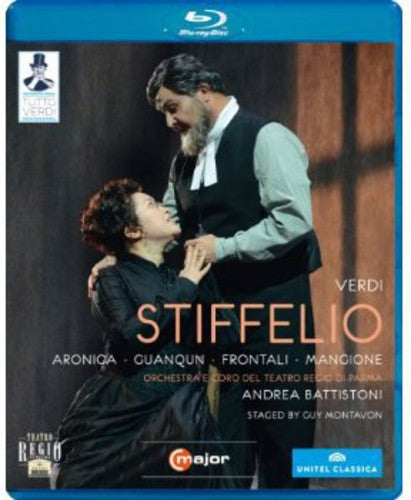
-
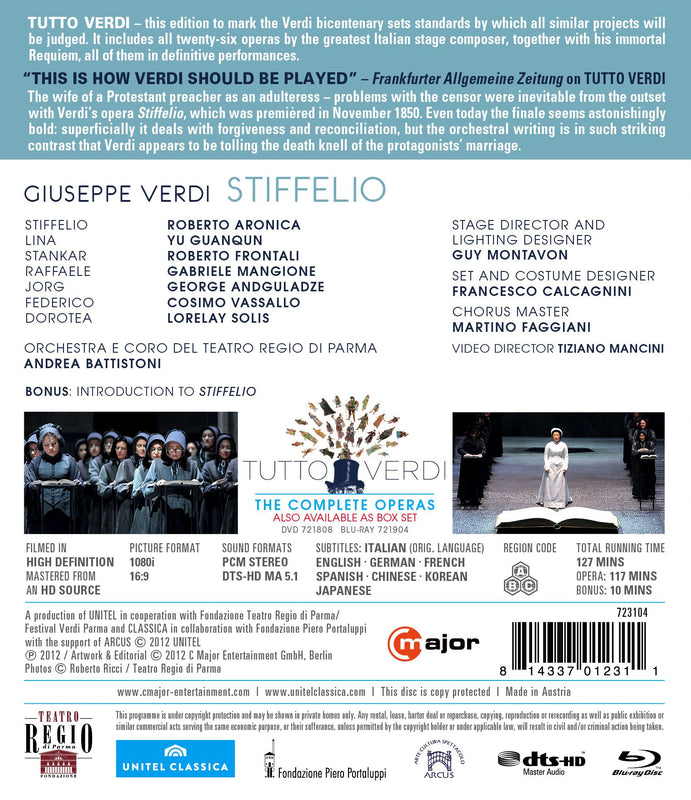
-
![Verdi: Stiffelio / Aronica, Guanqun, Frontali, Mangione, Battistoni [blu-ray]](//arkivmusic.com/cdn/shop/files/2142756.jpg?v=1749390639&width=800) {# optional: put hover video/second image here positioned absolute; inset:0 #}
On SaleC Major Entertainment
{# optional: put hover video/second image here positioned absolute; inset:0 #}
On SaleC Major EntertainmentVerdi: Stiffelio / Aronica, Guanqun, Frontali, Mangione, Battistoni [blu-ray]
Note: This Blu-ray Disc is playable only on Blu-ray Disc players, and not compatible with standard DVD players. Also available on standard...
March 26, 2013$37.99$18.99 -
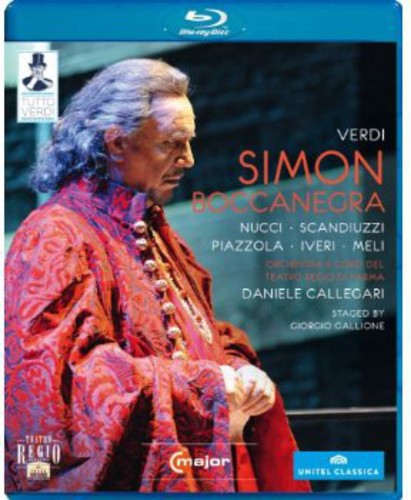
-
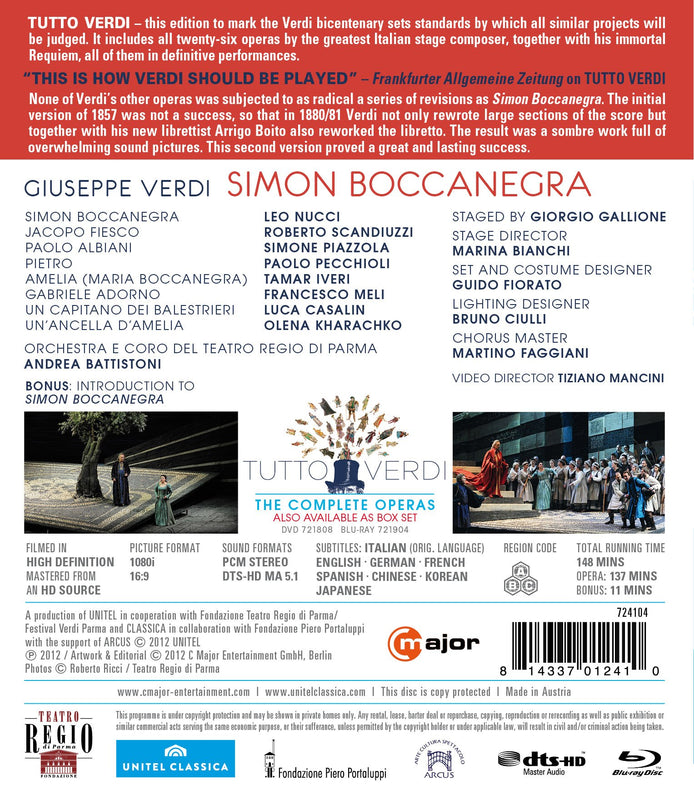
-
![Verdi: Simon Boccanegra / Callegari, Nucci, Scandiuzzi, Piazzola, Pecchioli [blu-ray]](//arkivmusic.com/cdn/shop/files/2165948.jpg?v=1749392512&width=800) {# optional: put hover video/second image here positioned absolute; inset:0 #}
C Major Entertainment
{# optional: put hover video/second image here positioned absolute; inset:0 #}
C Major EntertainmentVerdi: Simon Boccanegra / Callegari, Nucci, Scandiuzzi, Piazzola, Pecchioli [blu-ray]
This Blu-ray Disc is only playable on Blu-ray Disc players and not compatible with standard DVD players. Also available on standard DVD...
$66.99April 30, 2013 -
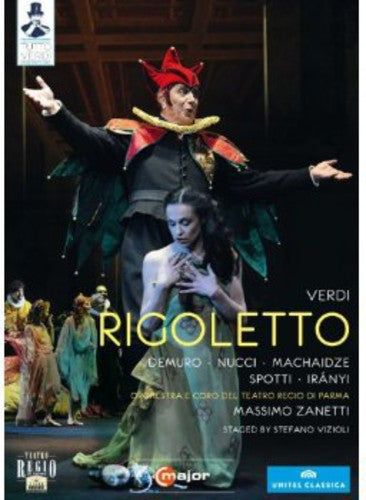
-
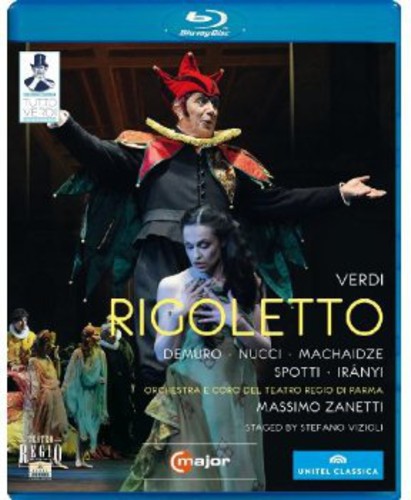
-
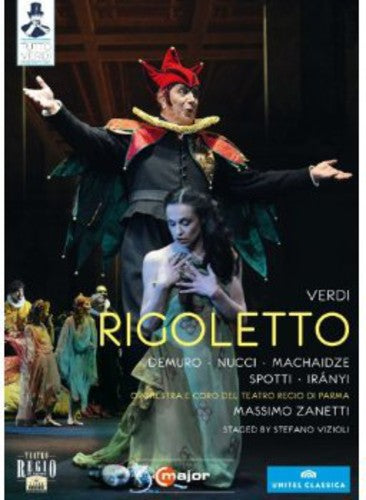 {# optional: put hover video/second image here positioned absolute; inset:0 #}
C Major Entertainment
{# optional: put hover video/second image here positioned absolute; inset:0 #}
C Major EntertainmentVerdi: Rigoletto / Demuro, Nucci, Machaidze, Zanetti
Also available on Blu-ray For Verdi, Victor Hugo’s play Le roi s’amuse was “arguably the greatest drama of the present day”. However...
$35.99March 26, 2013 -

-

-
 {# optional: put hover video/second image here positioned absolute; inset:0 #}
On SaleC Major Entertainment
{# optional: put hover video/second image here positioned absolute; inset:0 #}
On SaleC Major EntertainmentVERDI: Otello
A superb new Otello from the Salzburg Easter Festival: “Cura is a commanding Otello with his richly coloured tenor and both fragile...
April 28, 2017$35.99$17.99 -
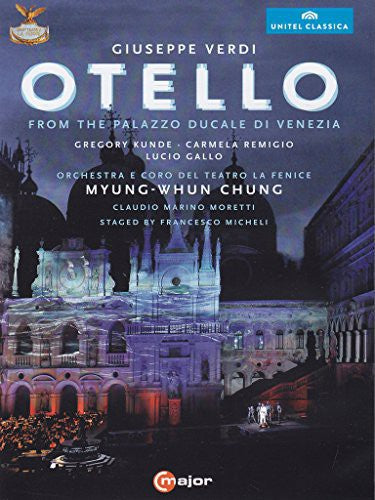
-
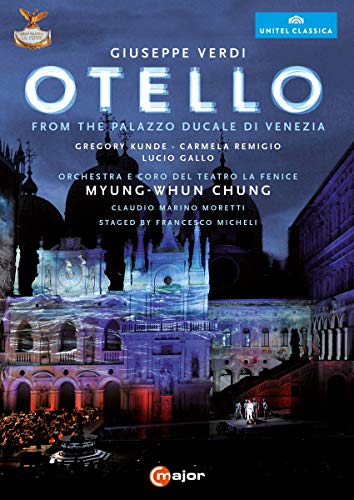
-
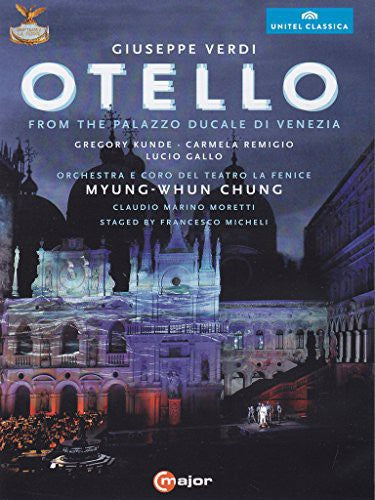 {# optional: put hover video/second image here positioned absolute; inset:0 #}
On SaleC Major Entertainment
{# optional: put hover video/second image here positioned absolute; inset:0 #}
On SaleC Major EntertainmentVerdi: Otello / Chung, Kunde, Remigio, Gallo
Rarely has a production of Verdi's "Otello" taken place in such a prestigious location, the courtyard of the Palazzo Ducale in Venice....
June 24, 2014$26.99$13.49
Wagner: Parsifal / Sinopoli, Struckmann, Watson, Elming, Holle
Richard Wagner
PARSIFAL
Amfortas – Falk Struckmann
Titurel – Matthias Hölle
Gurnemanz – Hans Sotin
Parsifal – Poul Elming
Klingsor – Ekkehard Wlaschiha
Kundry – Linda Watson
Bayreuth Festival Chorus and Orchestra
Giuseppe Sinopoli, conductor
Wolfgang Wagner, stage director and set designer
Recorded live from the Bayreuth Festival, 1998.
Picture format: NTSC 16:9 anamorphic
Sound format: PCM Stereo / DTS 5.1
Region code: 0 (worldwide)
Subtitles: German, English, French, Spanish
Running time: 268 mins
No. of DVDs: 2 (DVD 9)
R E V I E W:
WAGNER Parsifal • Giuseppe Sinopoli, cond; Poul Elming ( Parsial ); Linda Watson ( Kundry ); Falk Struckmann ( Amfortas ); Hans Sotin ( Gurnemanz ); Ekkehard Wlaschiha ( Klingsor ); Matthias Hölle ( Titurel ); Bayreuth Fest Ch & O • ORFEO 10561 (2 DVDs: 268:00) Live: Bayreuth 7/6–13/1998
For the most part, in recent decades the Bayreuth Festival has been a veritable chamber of horrors when it comes to opera stagings, the most recent example being the widely publicized Katherina Wagner abomination of Die Meistersinger . (Andrew Quint gave it a glowing review in Fanfare 34:6; he and I usually have antipodal views on virtually everything Wagnerian—a useful reference point for Fanfare readers, no doubt—and here I could not possibly disagree with him more.) Thankfully, especially since Parsifal is one of my three or four very favorite operas, this time we have instead an instance of what Bayreuth can produce at its considerable peak. While not flawless, this is one of the best-sung and -staged productions of any Wagner opera, let alone Parsifal , yet to grace a DVD, and thus a significant addition to the Wagner discography.
Dating back to 1999, this release is a belated tribute to conductor Giuseppe Sinopoli, whose premature death in 2001 from a heart attack while conducting Aida at the Deutsche Oper in Berlin deprived the classical-music world of one of its more polarizing figures. Like many others, I found some of his interpretations to be illuminating but others maddening, the latter mainly for their perverse manipulations of tempi. Here, he is on his best behavior; his pacing of the score is quite broad, lasting almost four and a half hours, but somehow does not feel as extreme as either the monumental Hans Knappertsbusch or torpid James Levine. (Paradoxically, his one serious miscalculation is the opening of act II, taken at a manic clip faster than any other rendition I’ve ever heard and unfortunately losing some of its profoundly sinister edge as a result.) Taking proper advantage of the unique acoustics of the Bayreuth Festspielhaus —for me, a virtual sine qua non for this score—he produces an orchestral sound that is luminous and radiant, with superb balance of all the instruments and uncommonly clear delineation of oscillating string figurations typically obscured by melody lines in the brass and winds. The great irony here is that no camera was stationed in the covered orchestra pit, so we never get to see either Sinopoli or the orchestra, since no curtain calls were filmed, either. (Thankfully, following the longstanding custom for this work of which I heartily approve, there also is no applause after the acts.)
The staging, abstract in principle but naturalistic in impact, is quite effective in suggesting a mythic timelessness. During the act I prelude, in a clear nod to that of Lohengrin , the chalice gradually becomes visible, descends from Heaven, fills the screen, and then gradually recedes and disappears. The outdoor scenes—the forest of the kingdom of the Grail Knight, the garden of the Flower Maidens—are dominated by flanking sets of tall columns with multifaceted irregular planar faces. By skilled and imaginative use of lighting, these assume various colors appropriate to their settings. For the forest scenes in act I they turn an intensely dark forest green that provides a far more intense impression of trees and dense vegetation than does the foliage used in completely naturalistic stagings. In act III their color is bleached to a far more pale green, symbolically indicating the subsequent decline of the Grail kingdom. For the Flower Maidens scene they are bathed in a ghostly twilight blue when the maidens first enter, and then take on shimmering dark blue and red hues during the seduction scene “Komm, komm, holder Knabe!” Other physical aspects of the staging have also been thought out with care. An opening aperture for the hall of the Grail knights, in which the gravely wounded Amfortas is positioned (in the simple sedan chair used to transport him) to preside over the Eucharistic rite, is symbolically shaped like a casket. The floor of the hall, defined in the back by attractive slate-blue and gray walls, is given an octagonal shape—presumably a reference to the shape of a traditional baptismal font—inlaid with an intriguing maze figuration. This not only evokes a medieval church labyrinth, but also intuitively suggests both the laborious path the knights must pursue to attain holiness and the confusion caused by the fall of their leader into sin. The octagonal shape is used as a unitary device in several other ways to great effect; it is the shape of both the “kitchen island” style altar in the hall, the pit from which Kundry emerges at Klingsor’s command in act II, and the seat on which she reclines in her attempt to seduce Parsifal, insightfully signifying that endeavor to be a sexual profanation of the chaste Eucharistic rite. Likewise, the abstract fortress walls of Klingsor’s castle, with the magician confined between them and visible through only a narrow aperture, aptly suggests a claustrophobic realm of evil. In act III an egg-shaped fountain as a symbol of spiritual rebirth also emerges from an octagonal opening in the stage. (Though not bad-looking, it unavoidably brings to mind Anna Russell’s “Erda the green-faced torso” popping out of the earth.)
Striving for a similarly timeless atmosphere, but somewhat less successfully, are the costumes, stage props, and acting. In act I the squires and knights of the Grail kingdom wear short coats and pants bearing a risible resemblance to those worn by soldiers of the Empire in the original Star Wars film. Fortunately the other costumes are better. Gurnemanz and the knights bearing Amfortas are clad in simple full-length robes with matching tunics, in subdued shades of blue and green-gray; Amfortas is clad in a dark red tunic at his first appearance and a purple one in the scene of the Eucharistic rite, respectively signifying his wound and his royal rank. By contrast, the sorcerer Klingsor parodies the plain garb of his erstwhile fellow knights, sporting a dark forest-green robe overlaid by a tunic with broad stripes in brilliant metallic shades of violet, light red, dark red, and blue. Kundry wears simple white habits in acts I and III but exchanges those for an alluring pink gown in act II. In act III the Grail Knights are much improved in appearance by the addition of full-length white capes, metal cap helmets, and swords. As for the props, the dead swan and Parsifal’s bow are suitable, but the spear and chalice are risibly hokey. The former looks like it was ordered from an Ikea catalog, and its tip glows an electronic pink after its healing touch to Amfortas in act III. The chalice has an ornately carved crystal glass upper portion; after the wine is consecrated a red light bulb glows ludicrously inside it, and interior radiance is badly bungled by use of a white strobe light. One hates to criticize attempts to realize the composer’s detailed specifications, and perhaps these elements looked much better at a distance from the audience, but a close-up camera is most unforgiving. The acting by one and all is conscientious but staid and wooden, and there is one badly miscalculated piece of stage business at the very end: Instead of Kundry dying as the libretto states, she steps forward and quite impossibly—in a medieval Catholic order of knights!—assists Parsifal in celebrating the Eucharist. A thoughtless piece of happy-ending sentimental slop? A theological-political plug for women’s ordination? Your guess is as good as mine.
Fortunately the singing is at a level of excellence matching the staging. Top honors go to the always superb Hans Sotin as Gurnemanz. In his previous DVD outing in the role from 17 years before (also at Bayreuth) he sang very well indeed, but was somewhat light in timbre and could not match the solemn nobility of Ludwig Weber and Kurt Moll; but here both the voice and interpretation have deepened to provide a portrayal joining theirs in the very top echelon. Equally superb is Linda Watson, who has the rare combination of qualities needed for a complete Kundry: a voice that is rich, warm, vibrant, powerful, and absolutely steady, and sweetly seductive, impassioned, and earthy by turns. As Parsifal, Poul Elming is that rarity of rarities, a true Heldentenor with a properly baritonal timbre and vocal heft. The vibrato is steady and the top notes secure and effortless; an occasional slight bleatiness presages the vocal decline that would beset him a few years later, but here adds a welcome touch of vulnerability to the interpretation. If not quite on the stellar level of Siegfried Jerusalem in the aforementioned 1982 Bayreuth performance, he is the equal or superior of other rivals, including Wolfgang Windgassen and Plácido Domingo. Falk Struckmann and Matthias Hölle are two singers of whom I have generally fought shy due to unfocused, wobbly vocal production, but here both are on best behavior. As Amfortas, Struckmann is still a bit diffuse, but not to a degree I find disturbing, and here in alliance with a plangent tone that actually adds to the character’s pathos and wounded vulnerability, while Hölle as Titurel is rock-solid and suitably sepulchral. Only Ekkehard Wlaschiha as Klingsor is on a somewhat lower plane; his voice is still powerful and stable and his interpretation impassioned, but wear and tear from years of heavy use have set in and the emission is now forced and dry, with a certain degree of barking rather than singing. Still, while he is no Hermann Uhde, he is better than most other alternatives.
The recorded sound is excellent, capturing the Bayreuth acoustic to the full. The camerawork is solid but cautious and unenterprising; the 12-year delay between filming and commercial release makes me wonder if it was filmed for archival purposes rather than public distribution. Whatever the case, it now ranks as one of three Parsifal s on DVD to which a hearty recommendation can be given, the other two being the 1982 Bayreuth production and the 1992 Metropolitan Opera staging, both on DG. The 1982 Bayreuth version features dull, drab sets by Wolfgang Wagner and some absurd stage business (notably, in act III the knights move in to kill Amfortas just as Parsifal arrives to save the day), but it boasts committed acting and a uniformly strong vocal cast of Eva Randova, Siegfried Jerusalem, Bernd Weikl, Leif Roar, Hans Sotin, and Matti Salminen, with Horst Stein leading a swift but never rushed performance; it’s worth getting just for the audio portion. The 1992 Met outing features an attractive naturalist staging by Otto Schenck but more uneven musical values. A decade older, the voices of Jerusalem and Weikl are now noticeably more strained though still quite acceptable; Kurt Moll and Waltraud Meier are magnificent, but Jan-Hendrik Rootering is a somewhat woofy Titurel, one must try to tolerate the intolerable Franz Mazura as Klingsor, and James Levine is mired in his slower-than-molasses-in-January podium mode of that time, though somehow he stills mostly makes it work. All other DVD versions feature Eurotrash productions with horribly inept singing to boot. On CD I would especially recommend the fabled 1951 Bayreuth performance, available on several labels, with Martha Mödl, Wolfgang Windgassen, George London, Hermann Uhde, Ludwig Weber, and Hans Knappertsbusch (vastly superior to the oft-recommend Knappertsbusch Bayreuth performance of 1962) and—despite the inadequate Peter Hofmann in the title role—the 1981 DG recording with Dunja Vejzovic, José van Dam, Siegmund Nimsgern, Kurt Moll, and the Berlin Philharmonic under Herbert von Karajan. Worthy if lesser alternatives include a 1953 Bayreuth outing, also issued on various labels, in which Ramón Vinay and Clemens Krauss replace Windgassen and Knappertsbusch, and a 1971 Bayreuth performance on Melodram with Janis Martin, Sandór Konya, Thomas Stewart, Gerd Nienstedt, Franz Crass, and Eugen Jochum. Finally, mavens of historical recordings with high tolerance for poor recorded sound will look to the 1936 Teatro Colón performance on Marston with Marjorie Lawrence, René Maison, Martial Singer, Fred Destal, and Alexander Kipnis led by Fritz Busch, and the 1938 Met broadcast (with 10-second gaps in sound every four minutes due to use of a single recording turntable) featuring Kirsten Flagstad, Lauritz Melchior, Friedrich Schorr, Arnold Gabor, and Emmanuel List, with Artur Bodansky leading acts I and III and Eric Leinsdorf stepping in for his temporarily indisposed colleague in act II. The Guild label has issued an intact act II of this performance in superior sound preserved from a different source.
FANFARE: James A. Altena
Wagner: Götterdammerung / Mehta, Ryan, Lukas, Salminen
GÖTTERDÄMMERUNG
Siegfried – Lance Ryan
Gunther – Ralf Lukas
Alberich – Franz-Josef Kapellmann
Hagen – Mattil Salminen
Brünnhilde – Jennifer Wilson
Gutrune – Elisabete Matos
Waltraute – Catherine Wyn-Rogers
First Norn – Daniela Denschlag
Second Norn – Pilar Vázquez
Third Norn – Eugenia Bethencourt
Woglinde- Silvia Vázquez
Wellgunde – Ann-Katrin Naidu
Flosshilde – Marina Prudenskaja
Valencia Regional Government Choir (Cor de la Generalitat Valenciana)
Valencian Community Orchestra (Orquestra de la Comunitat Valenciana)
Zubin Mehta, conductor
La Fura del Baus, staging
Carlus Padrissa, stage director
Recorded live from the Palau de les Arts "Reina Sofia", Valencia, Spain, 2009.
Bonus feature:
- The making of Götterdämmerung
Picture format: NTSC 16:9
Sound format: PCM Stereo / Dolby Digital 5.1 (opera) / Dolby Digital 2.0 (bonus)
Region code: 0 (worldwide)
Subtitles: German, French, English, Spanish (opera) / English (bonus)
Booklet notes: German, French, English
Running time: 280 mins (opera) + 27 mins (bonus)
No. of DVDs: 2 (DVD 9)
Wagner Gala / Kaufmann, Thielemann, Dresden
THE WAGNER GALA
In memory of the great Richard Wagner and mindful of their own Wagner tradition, the Staatskapelle Dresden staged this glittering gala concert in the Semperoper on the eve of Richard Wagner’s bicentenary. They were directed by their principal conductor Christian Thielemann, indisputably one of the great Wagner conductors of our time, and he was joined by the hottest young heroic tenor of recent years, Jonas Kaufmann. The programme features the overtures to the Wagner operas written and premiered in Dresden – 1842 Rienzi, 1843 The Flying Dutchman and 1845 Tannhäuser – as well as great tenor scenes from Rienzi, Tannhäuser and Lohengrin. “Star tenor Jonas Kaufmann was celebrated with bravos and tumultuous applause – as were the musicians and Thielemann.” (Focus)
Richard Wagner:
Der fliegende Holländer: Overture
A Faust Overture
Rienzi (excerpts)
Lohengrin (excerpts)
Tannhäuser (excerpts)
Hans Werner Henze: Fraternité
Jonas Kaufmann, tenor
Dresden Staatskapelle
Christian Thielemann, conductor
Recorded live at the Semperoper, Dresden, 21 May 2013
Picture format: NTSC 16:9
Sound format: Dolby Digital 2. 0 / DTS 5.1
Region code: 0 (worldwide)
Subtitles: German, English, French, Spanish, Korean, Chinese
Running time: 117 mins
No. of DVDs: 1 (DVD 9)
Wagner: Die Walküre / Thielemann, Staatskapelle Dresden
Overall this production, designed originally and very specifically for the very wide stage of the Festspielhaus, impresses as a worthwhile piece of theatrical archaeology, for the initial production concept of the Ring as a whole cosmos, and its homage to the stripped-back aesthetic of Wieland Wagner’s Bayreuth, remain highly effective scenically. There are just enough long shots to remind us of the epic scale within which the intimate drama is unfolding. The giant tree that also forms Hunding’s hut in Act I, and the ring-shaped platform for Act II, still functions well – simple, effective design does not date. The chalked up listing of the cast of characters on the floor, then back wall, in Act II is an intelligent reminder that after Das Rheingold, the Ring is deeply engaged with its own back-story, like the Oresteia of Aeschylus that formed part of its genesis. One wonders what Karajan would have made of some new directorial details, such as Hunding’s nastily aggressive groping of Sieglinde’s crotch, but generally the characters and their situations are well served by the direction. There is little here to upset a traditionalist, for Brünnhilde even has a winged helmet and a spear for the great ‘annunciation of death’ scene with Siegmund in Act II. The filming, editing and sound recording do it all justice.
Karajan liked younger, fresher voices rather than what he called the “old Wagnerian cannons”. He would not have liked Siegmund’s ill-focussed barking of “Wälse, Wälse” in Act I, but for much of the part Peter Seiffert still makes a very good Walsung. Anja Harteros has the measure of his twin Sieglinde to a still greater degree, vocally bright and secure through the range, and looking the part. Christa Mayer as Fricka is outstanding too, imposing in her insistence on her moral stance, but in full command of her rich voice so that she is never shrill or shrewish, which gives her an authority that makes the drama more interestingly ambiguous. It’s not just a case here, as it sometimes is, of ‘Fricka wrong, Wotan right’. The Wotan of Vitalij Kowaljow is splendidly focussed of voice and suitably imposing in presence – not at all the sort of woolly-voiced veteran Wotan which is the undoing of too many recordings of this work. Anja Kampe is on top vocal form as Brünnhilde, whose interactions with Wotan are the emotional heart of this most human of the Ring dramas. Her wide experience in Wagner really tells, and she acts and sings those scenes with her father most affectingly. Her eight spear-voiced (and spear-carrying) Valkyrie sisters make a joyous noise in the opening to Act III.
Christian Thielemann’s pedigree could hardly be more auspicious for this enterprise, since as a young man he was an assistant to Karajan, as well as to Barenboim at Bayreuth. He even followed the traditional route of progressing through smaller German opera houses, learning his craft en route to his current eminence as one of the world’s leading Wagner conductors. His musical direction is superb, for he has the essential long-term perception of Wagner’s musico-dramatic structures, control of the broad tempi he often favours, and a truly magnificent orchestra in the Dresden Staatskapelle. Like Karajan, he understands that the drama is essentially in the pit. Perhaps too Thielemann was inspired by this reclamation of a classic production by his mentor. Karajan once said in a BBC interview “When I see staging and lighting that is right, the music runs out of my hand without effort”. So it does for Thielemann here, not least in the magnificent account of Wotan’s moving farewell to his favourite daughter that closes the opera.
– MusicWeb International (Roy Westbrook)
The sound of Thielemann’s orchestra, darker-sounding than usual from more Western-based orchestras and with plangent winds and an aggressively present timpani balance, is one of the pleasures of this set. Thielemann has long been a ‘stopgoer’ in Wagner with large tempo contrasts. Now, perhaps following his Bayreuth Tristan, he is even more daringly slow in his pointing up of love and suffering. For that and the cast this set is valuable.
– Gramophone
Wagner: Die Walkure / Mehta, Seiffert, Schnitzer, Wilson
Richard Wagner
DIE WALKÜRE
Siegmund – Peter Seiffert
Hunding – Matti Salminen
Wotan – Juha Uusitalo
Sieglinde – Petra-Maria Schnitzer
Brünnhilde – Jennifer Wilson
Fricka – Anna Larsson
Gerhilde – Bernadette Flaitz
Ortlinde – Helen Huse Ralston
Waltraute – Pilar Vázquez
Schwertleite – Christa Mayer
Helmwige – Eugenia Bethencourt
Siegrune – Heike Grötzinger
Grimgerde – Manuela Bress
Rossweisse – Hannah Ester Minutillo
Valencian Community Orchestra (Orquestra de la Comunitat Valenciana)
Zubin Mehta, conductor
La Fura del Baus, staging
Carlus Padrissa, stage director
Recorded live from the Palau de les Arts "Reina Sofia", Valencia, Spain, 2008.
Bonus feature:
- The making of Die Walküre
Picture format: 1080i Full HD
Sound format: PCM Stereo / DTS-HD Master Audio 7.1 (opera) / Dolby Digital 2.0
Region code: 0 (worldwide)
Subtitles: German, French, English, Spanish (opera) / English (bonus)
Booklet notes: German, French, English
Running time: 245 mins (opera) + 27 mins (bonus)
No. of Discs: 1 (BD 50)
Wagner: Der Ring des Nibelungen Highlights / Mehta, Valencia Orchestra
Richard Wagner
DER RING DES NIBELUNGEN
(Highlights)
Wotan / Der Wanderer – Juha Uusitalo
Loge – John Daszak
Alberich – Franz-Josef Kapellmann
Fasolt / Hunding – Matti Salminen
Fafner – Stephen Milling
Fricka – Anna Larsson
Erda / Schwertleite – Christa Mayer
Siegmund – Peter Seiffert
Sieglinde – Petra-Maria Schnitzer
Brünnhilde – Jennifer Wilson
Siegfried – Lance Ryan
Mime – Gerhard Siegel
Waltraute / Erda – Catherine Wyn-Rogers
Valencia Regional Government Choir (Cor de la Generalitat Valenciana) Valencian Community Orchestra (Orquestra de la Comunitat Valenciana) Zubin Mehta, conductor
La Fura del Baus, staging
Carlus Padrissa, stage director
Recorded live from the Palau de les Arts "Reina Sofia", Valencia, Spain, 2007-2009.
Special budget-priced DVD
100 minutes of the most stunning visual and musical highlights of this production by La Fura dels Baus, including two new documentaries about Franc Aleu and Carlus Padrissa.
Bonus:
- Portraits of Carlus Pardissa and Franc Aleu
Picture format: NTSC 16:9
Sound format: DTS 5.1 (highlights) / PCM Stereo (bonus)
Region code: 0 (worldwide)
Subtitles: German, French, English, Spanish (highlights) / English (bonus)
Running time: 100 mins (highlights) + 30 mins (bonus)
No. of DVDs: 1
R E V I E W:
It might seem I am about to trash this issue but I am actually very impressed by the Valencia Ring so do please read on.
The DVD menu and title sequence is accompanied by music, which is to be deplored. Please can we have silence in these places on concert and opera videos. No one wants to hear the same truncated chunks over and over again whilst trying to work through the labyrinth to get DTS5.1 instead of stereo and subtitles in the right language. The sound is only in PCM stereo anyway on this section just to add to the confusion. The transitions between sections are handled by simple fade-outs; disruptive if you know the music well but what else can one do in The Ring? The length of pauses is variable from almost nothing to several seconds. Though the extracts are in dramatic order there is no indication of where you are in the operas nor is there any hint that one has changed opera, just randomly timed fades in and out. The worst example is the end of Act 1 of The Valkyrie which stops barely a couple of seconds before a chunk of Act 2. I suspect the tea-boy was in charge of post production. I am relieved to say all is well apart from these technical blots and since the music and production are so entertaining, and the sound and picture is so good, one can forgive Unitel these flaws. Do keep the booklet to hand whilst viewing and don't even bother with this DVD if you don't have another complete recording in your collection because you will get hopelessly lost without a plot summary.
Most opera productions are characterised by their appearance rather than by the performance. It is almost impossible to ignore what you are seeing and it often clashes with what you are hearing. To my knowledge only Bruckner managed to get through The Ring without noticing that there were costumes and scenery involved! The Valencia production is no different. It is dominated by huge video projections throughout and the DVD production often takes advantage of these to add its own layers of image for dramatic effect. Stage lighting is extremely dramatic which enhances the startling images still more. If you like to see people standing and singing against a plain background à la Bayreuth 1960s then you will hate it because this one really grasps the technical challenge and goes with it. The singing is of uniformly high quality and the conducting of Zubin Mehta is fine so long as you do not expect Solti's fierce drive. The orchestra are excellent and even get a scene for themselves in the prelude to Act 3 of Siegfried. Since you will only buy this to check if it is to be love or hate so far as you are concerned before either ignoring it forever, or ordering the entire cycle on Blu-ray, these are some of the delights in store.
Loge has a great little motor scooter with which to run rings around the rest of the cast literally as well as figuratively. The costumes are complicated and often look very heavy which makes the little cranes used on and off through the cycle to carry characters around the stage very understandable. Act 1 of The Valkyrie has a wonderfully effective and very subtle tree which bears careful study. This creation looms over a decidedly stone-age looking Sieglinde and a very tough Siegmund. These two Walsungs look highly dangerous to me and must have posed a serious problem for Hunding. Since we don't see him at all in these extracts we have no idea how he handles them. The Ride of the Valkyries looks fantastic and is well performed against huge and effective video backdrops. Lots of work for the cranes here! The ring of fire which Wotan places around Brunnhilde is a proper inferno as is the fire for Siegfried's forge which looks positively dangerous. Siegfried by the way can sing well but is a patchy actor as seen here. The forge is animated by many stage hands so that Notung appears to be a product of a busy factory rather than one superman. So much for Siegfried facing down Wotan's plans single-handed but since the helpers look like the Nibelung slaves in The Rhinegold it can be seen as logical. I wasn't so taken by Fafner who looks more like an articulated ventilation duct than anything supernatural but some productions even leave him out, such are the challenges of staging this part. Bayreuth once had the entire stage start to writhe, an effect of such impact that all others pall. The prelude to Act 3 of Siegfried has a massive back-projection of snow-covered mountains and eventually of the whole Earth from which Erda emerges in a moment of highly consequent majesty. Siegfried travels down the Rhine on a river of plastic drinks bottles which is utterly bizarre but does actually work - just believe me! The closing scene also manages to be consequent and we see Brunnhilde, on a crane, returning the Ring to the Rhine maidens before disappearing into the conflagration. The producers use lots of gymnasts in this and other scenes to great dramatic effect and the end here is close to awe-inspiring.
The 100 minutes of opera on the DVD is joined by 30 minutes of supporting documentary material. After some preliminary tele-visual nonsense one film describes the way the directorial team worked up their ideas to fulfil Wagner's intentions and sometimes his explicit instructions - now there's a novel idea - to do what the composer says. Others take note! The other film is about the important lighting design. Both are worth one's time.
A superb marketing tool for the entire cycle available on DVD and on Blu-ray. This performance and production is a great success overall and this DVD needs watching just once before you go out and buy the whole thing.
-- Dave Billinge, MusicWeb International
Verdi & Wagner - The Odeonsplatz Concert / Thomas Hampson, Ronaldo Villazon, Yannick Nezet-seguin
This scintillating opera gala offers you the chance to experience the Odeonsplatz Concert 2013 with Rolando Villazón, Thomas Hampson and Yannick Nézet-Séguin in all its glory, featuring opera arias, duets, overtures and choruses by Verdi and Wagner.
THE ODEONSPLATZ CONCERT – Verdi and Wagner
Klassik am Odeonsplatz
Giuseppe Verdi:
Les vêpres siciliennes (I vesperi siciliani): Overture
Don Carlos: Autodafé / Dio, che nell’alma infondere
L’esule (arr. L. Berio)
Il trovatore, Act II: Vedi, le fosche notturne, “Anvil Chorus”
Il corsaro, Act III: Alfin questo corsaro … Cento leddiadre vergini
Oberto, conte di San Bonifacio, Act II: Ciel, che feci!
Nabucco, Act III: Vá pensiero, “Chorus of the Hebrew Slaves”
Jules Massenet:
Hérodiade, Act II: Ce breuvage pourrait … Vision fugitive
Le Cid, Act III: Ah! tout est bien fini … Ô souverain, ô juge, ô pere
Maurice Ravel: La valse (version for orchestra)
Richard Wagner:
Lohengrin: Preludes to Acts I & III
Tannhäuser: O du mein holder Abendstern / Entry of the Guests on the Wartburg
Rolando Villazón, tenor
Thomas Hampson, baritone
Bavarian Radio Symphony Chorus
Bavarian Radio Symphony Orchestra
Yannick Nézet-Séguin, conductor
Recorded live at Odeonsplatz, Munich, 2013
Picture format: NTSC 16:9
Sound format: PCM Stereo / DTS 5.1
Region code: 0 (worldwide)
Subtitles: English, German, French, Spanish, Korean, Chinese, Japanese
Booklet notes: English, German, French
Running time: 111 mins
No. of DVDs: 1 (DVD 9)
Verdi: Un Giorno Di Regno / Loconsolo, Porta, Renzetti
VERDI Un giorno di regno • Donato Renzetti, cond; Guido Loconsolo (Belfiore); Anna Caterina Antonacci (Marchesa del Poggio); Ivan Magri (Edoardo); Alessandra Marianelli (Giulietta); Andrea Porta (Baron Kelbar); Paolo Bordogna (La Rocca); Teatro Regio di Parma O & Ch • C MAJOR 720304 (Blu-ray); 720206 (1 DVD: 119:00 opera, 10:00 bonus) Live: Parma 2010
Giuseppe Verdi’s second opera, Un giorno di regno, proved to be a real disaster, the opera was pulled from the stage at Milan’s La Scala after only one performance, during which the raucous crowd loudly vented their displeasure, sending the young composer into a paroxysm of despair. Yet conditions were never propitious for the opera’s success. Due to the favorable reception of Verdi’s first opera, Oberto Conte di San Bonifacio, he had been signed to compose three more for the Milan house. The intendent, Bartolomeo Merelli, decided at the last minute he needed a comedy to round out the new season, and Verdi was given a choice of several old discarded and rejected librettos from the house stock. According to Verdi himself, he picked the one he disliked least, an older work by Felice Romani, probably updated and touched up for him by house librettist, Temistocle Solera. Verdi’s métier was never comedy, he did not write another until his last, Falstaff, when he was nearly 80. This particular comedy, an opera buffa, was already old-fashioned for the times, employing secco recitatives (sung passages accompanied only by piano) long out of style. After only recently losing his young son to illness, while he worked on this new opera Verdi’s wife fell sick and died as well. Shocked and in grief, Verdi wanted nothing more to do with composing for comedic situations, but Merelli, desperate for the opera, cited the contract and forced the composer to finish the music in a rush. To top it off, the somewhat temperamental singers employed at La Scala were not committed to the work and one key singer was in bad voice. The result was predictable.
With all the above excuses now offered, my opinion of the work is considerably higher than that of the opening night crowd. They were hoping to see top notch Donizetti and only got average Rossini (still pretty good) with a dash of Verdi mixed in. The opera has some strong musical numbers and could easily be mistaken for an early Rossini piece, in fact it is quite reminiscent of Rossini’s first staged opera, La Cambiale di matrimonio, except that instead of one set of mismatched lovers, here we have two, in the pattern of romantic operetta, along with a pair of quarreling buffo basses. The tenor, Belfiore, is posing as the King of Poland while the real king carries out a delicate mission of state. Belfiore must not reveal his true identity while he is a guest at the castle of Kelbar in France. He is in love with a young widow, the Marchesa del Poggio (mezzo), who is also in attendance at the castle. The Marchesa recognizes Belfiore and gets wounded feelings because he won’t acknowledge her. She has been toying with another man, and in a fit of spite, announces she will marry him. Among the other characters are the junior pair of young lovers, penniless tenor Eduardo and his would-be girlfriend Giulietta, the daughter of castle owner Kelbar. Rounding out the lot are the two basses, Baron Kelbar himself, and La Rocca, the state treasurer, who also has his eye on Giulietta. Belfiore uses his royal powers to help straighten things out, and get everyone matched up properly again. When he is finally able to renounce the throne, the others accept the fait accompli with at least grudging good grace. Sound like Strauss Jr. or Franz Lehar? Verdi could probably have used their help, but he was half a century too early.
It may be a long time before a better case is made for Verdi’s maligned second opera than on this C Major video of a 2010 production from the Teatro Regio in Parma. This is set No. 2 in their Tutto Verdi project to record all of Verdi’s operas on high definition Blu-ray disc, and already one of the highlights of the series. Sets are stylish and traditional, costumes in period and finely appointed. Stage Director Pier Luigi Pizzi to his credit pretty much sticks to the story in this seldom seen work, although there is a quite enjoyable tongue-in-cheek bathing scene for the Marchesa where she gives us an old-fashioned strip tease as she disrobes. Mezzo Anna Caterina Antonacci still has the goods to make it riveting entertainment for we males. (And what is the Marchesa doing taking a bath at the castle when she is not an overnight guest? Who cares, it’s harmless and entertaining.) Antonacci sings quite wonderfully, as usual, and even assays Verdi’s coloratura with confident aplomb. Her creamy mezzo voice is always on pitch and she is one of the best actresses on the stage today. She gives the distinct impression that if Belfiore is lucky enough to end up with her she is going to be a handful. Hot young tenor Guido Loconsolo also brings plenty of vocal talent to the role of Belfiore and he looks great as well. The second set of lovers, tenor Ivan Magri and Italian soprano Alessandra Marianelli, despite a few wayward pitch problems are both more than satisfactory here. The quarreling buffo basses should be more properly termed quarreling buffo baritones, neither Andrea Porta as the baron nor Paolo Bordagna as La Rocca have the strong bottom range for a buffo bass (think Osmin in Mozart’s Die Entfuhrung aus dem Serail). Both do however bring a nice comedic flair which suits the story well. The chorus seems curiously muffled in a couple of spots but sings quite well when you can hear them, The Parma house orchestra here under conductor Donato Renzetti, seems quite capable, at least in early Verdi. I will be interested to see how they hold up in the blockbuster operas of middle Verdi and the even more demanding scores like Don Carlos and Aida.
Musical highlights include the cleverly written overture, quite reminiscent of Rossini, the virtuoso tenor aria “Pietoso al lungo pianto,” the mezzo soprano aria “Si mostri a chi l’adora,” and the septet, patterned after the septet in La Cenerentola, but not quite as tuneful or as funny. The staging of the septet here is quite reminiscent of the Cenerentola staging from Houston Grand Opera seen on DVD where everyone sits in chairs and pops up when it is their turn to sing, similar to the old Whack-a-Mole game at the carnival. There is a competing video version of Un giorno di regno being released this month with a strong cast on Hardy Classics which I have not seen, but I would recommend this set even if there were a dozen others out there; I am quite pleased with it.
FANFARE: Bill White
Verdi: Un Ballo In Maschera / Meli, Stoyanov, Gelmetti
Subtitles: English, German, French, Spanish, Italian, Japanese, Korean, Chinese
Booklet: English, German, French
No. of Discs: 1
Run time: 146 minutes
Disc Format: DVD9
Picture: NTSC, 16:9
Audio: PCM Stereo, PCM 5.1
Bonus Material: Introduction to Un ballo in maschera
Subtitles Bonus: Italian, English
Region Code: 0 (worldwide)
Verdi: Un ballo in maschera / Mehta, Bavarian State Orchestra

Praise for the Bayerische Staatsoper's new Ballo in Maschera: "A formidable vocal feast" (Bayerische Staatszeitung). Ten years after stepping down as music director fo the Bavarian State Opera, a "grand Zubin Mehta" (Bayerischer Rundfunk) returned to Munich in March, 2016 to celebrate his 80th birthday conducting Verdi's masterpiece for the first time in a staged production. His cast features some of today's finest Verdi singesr: soprano Anja Harteros, singing "Amelia" for the first time and "filling every note with Verdian intensity", tenor Piotr Beczala as a "visually and vocally dashing Riccardo" and George Petean as an "exemplary" Renato (Neue Musikzeitung). In director Johannes Erath's musically super-sensitive new production, this historically-based tale of illicit love, conspiracy and betrayal unfolds in a surrealistic, shadowy setting transformed by lighting and projections. Special praise was showered by the enthusiastic critics on Maestro Mehta, who "creates concentrated musical connections, miraculously guiding his orchestra and unsurpassable voices the way a thermal lifts a paraglider...Musically the performance was a dream" (Frankfurter Allgemeine Zeitung). "A total triumph" (La Razon). "This production shows what a utopia opera can be" (Abendzeitung).
Verdi: Stiffelio / Aronica, Guanqun, Frontali, Mangione, Battistoni [blu-ray]
Also available on standard DVD
Giuseppe Verdi
STIFFELIO
(Blu-ray Disc Version)
Stiffelio – Roberto Aronica
Lina – Yu Guanqun
Stankar – Roberto Frontali
Raffaele – Gabriele Mangione
Jorg – George Andguladze
Federico di Frengel – Cosimo Vassallo
Dorotea – Lorelay Solis
Parma Teatro Regio Chorus and Orchestra
(chorus master: Martino Faggiani)
Andrea Battistoni, conductor
Guy Montavon, stage director and lighting designer
Francesco Clacagnini, set and costume designer
Recorded live at the Teatro Regio di Parma, 18 and 24 April, 2012
Bonus:
- Introduction to Stiffelio
Picture format: 1080i High Definition
Sound format: PCM Stereo / DTS-HD Master Audio 5.1
Region code: 0 (worldwide)
Subtitles: Italian, English, German, French, Spanish, Chinese, Korean, Japanese
Running time: 117 mins (opera) + 10 mins (bonus)
No. of Discs: 1 (BD 50)
Verdi: Simon Boccanegra / Callegari, Nucci, Scandiuzzi, Piazzola, Pecchioli [blu-ray]
Also available on standard DVD
Giuseppe Verdi
SIMON BOCCANEGRA
Simon Boccanegra – Leo Nucci
Jacopo Fiesco – Roberto Scandiuzzi
Paolo Albiani – Simone Piazzola
Pietro – Paolo Pecchioli
Amelia (Maria Boccanegra) – Tamar Iveri
Gabriele Adorno – Francesco Meli
Un capitano dei balestrieri – Luca Casalin
Un’ancella di Amelia – Olena Kharachko
Parma Teatro Regio Chorus and Orchestra
(chorus master: Martino Faggiani)
Daniele Callegari, conductor
Giorgio Gallione, staging
Marina Bianchi, stage director
Guido Fiorato, set and costume designer
Bruno Ciulli, lighting designer
Recorded live from the Teatro Regio di Parma, 23, 25, and 28 March 2010
Bonus:
- Introduction to Simon Boccanegra
Picture format: 1080i High Definition
Sound format: PCM Stereo / DTS-HD Master Audio 5.1
Region code: 0 (worldwide)
Subtitles: Italian, English, German, French, Spanish, Chinese, Korean, Japanese
Running time: 137 mins (opera) + 11 mins (bonus)
No. of Discs: 1
Verdi: Rigoletto / Demuro, Nucci, Machaidze, Zanetti
For Verdi, Victor Hugo’s play Le roi s’amuse was “arguably the greatest drama of the present day”. However many of his contemporaries were appalled by this tale of corpses, jesters, cripples and a king addicted to venal love. This no doubt explains why Rigoletto was Verdi’s second great success and laid the foundation for his emergence as Italy’s leading opera composer.
Giuseppe Verdi
RIGOLETTO
Il duca di Mantova – Francesco Demuro
Rigoletto – Leo Nucci
Gilda – Nino Machaidze
Sparafucile – Marco Spotti
Maddalenna – Stefanie Irányi
Giovanna – Katarina Nikolic
Il conte di Monterone – Roberto Tagliavini
Marullo – Orazio Mori
Matteo Borsa – Mauro Buffoli
Il conte di Ceprano – Ezio Maria Tisi
La contessa di Ceprano – Scilla Cristiano
Un usciere di corte – Alessandro Bianchini
Un paggio della duchessa – Scilla Cristiano
Parma Teatro Regio Chorus and Orchestra
(chorus master: Martino Faggiani)
Massimo Zanetti, conductor
Stefano Vizioli, stage director
Alessandro Ciammarughi, set and costume designer (after Pierluigi Samaritani)
Franco Marri, lighting designer
Recorded live at the Teatro Regio di Parma, 16, 20, and 22 October 2008
Bonus:
- Introduction to Rigoletto
Picture format: NTSC 16:9
Sound format: PCM Stereo / DTS 5.1
Region code: 0 (worldwide)
Subtitles: Italian, English, German, French, Spanish, Chinese, Korean, Japanese
Running time: 131 mins (opera) + 10 mins (bonus)
No. of DVDs: 1 (DVD 9)
VERDI: Otello
Verdi: Otello / Chung, Kunde, Remigio, Gallo
Giuseppe Verdi
OTELLO
Otello - Gregory Kunde
Desdemona - Carmela Remigio
Jago - Lucio Gallo
Emilia - Elisabetta Martorana
Cassio - Francesco Marsiglia
Roderigo - Antonello Ceron
Lodovico - Mattia Denti
Montano - Matteo Ferrara
Un Araldo - Antonio Casagrande
Teatro la Fenice Chorus and Orchestra
(chorus master: Claudio Marino Moretti)
Myung-Whun Chung, conductor
Francesco Micheli, stage director
Edoardo Sanchi, set designer
Silvia Aymonino, costume designer
Fabio Barettin, lighting designer
Recorded from the Palazzo Ducale di Venezia, 2013
Picture format: NTSC 16:9
Sound format: PCM Stereo / DTS 5.1
Region code: 0 (worldwide)
Subtitles: Italian, German, English, French, Spanish, Chinese, Japanese
Booklet notes: English, German, French
Running time: 149 mins
No. of DVDs: 1 (DVD 9)




 {# optional: put hover video/second image here positioned absolute; inset:0 #}
{# optional: put hover video/second image here positioned absolute; inset:0 #}



 {# optional: put hover video/second image here positioned absolute; inset:0 #}
{# optional: put hover video/second image here positioned absolute; inset:0 #}


 {# optional: put hover video/second image here positioned absolute; inset:0 #}
{# optional: put hover video/second image here positioned absolute; inset:0 #}



 {# optional: put hover video/second image here positioned absolute; inset:0 #}
{# optional: put hover video/second image here positioned absolute; inset:0 #}


 {# optional: put hover video/second image here positioned absolute; inset:0 #}
{# optional: put hover video/second image here positioned absolute; inset:0 #}



 {# optional: put hover video/second image here positioned absolute; inset:0 #}
{# optional: put hover video/second image here positioned absolute; inset:0 #}


 {# optional: put hover video/second image here positioned absolute; inset:0 #}
{# optional: put hover video/second image here positioned absolute; inset:0 #}


 {# optional: put hover video/second image here positioned absolute; inset:0 #}
{# optional: put hover video/second image here positioned absolute; inset:0 #}


 {# optional: put hover video/second image here positioned absolute; inset:0 #}
{# optional: put hover video/second image here positioned absolute; inset:0 #}


 {# optional: put hover video/second image here positioned absolute; inset:0 #}
{# optional: put hover video/second image here positioned absolute; inset:0 #}


![Verdi: Stiffelio / Aronica, Guanqun, Frontali, Mangione, Battistoni [blu-ray]](http://arkivmusic.com/cdn/shop/files/2142756.jpg?v=1749390639&width=800) {# optional: put hover video/second image here positioned absolute; inset:0 #}
{# optional: put hover video/second image here positioned absolute; inset:0 #}


![Verdi: Simon Boccanegra / Callegari, Nucci, Scandiuzzi, Piazzola, Pecchioli [blu-ray]](http://arkivmusic.com/cdn/shop/files/2165948.jpg?v=1749392512&width=800) {# optional: put hover video/second image here positioned absolute; inset:0 #}
{# optional: put hover video/second image here positioned absolute; inset:0 #}


 {# optional: put hover video/second image here positioned absolute; inset:0 #}
{# optional: put hover video/second image here positioned absolute; inset:0 #}


 {# optional: put hover video/second image here positioned absolute; inset:0 #}
{# optional: put hover video/second image here positioned absolute; inset:0 #}


 {# optional: put hover video/second image here positioned absolute; inset:0 #}
{# optional: put hover video/second image here positioned absolute; inset:0 #}